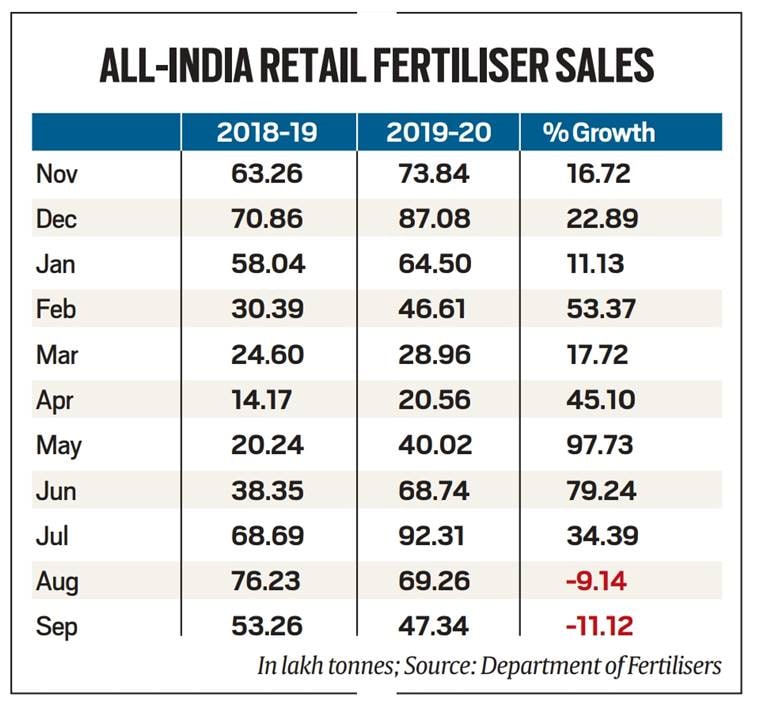The Indian Express
October 19, 2020
THE CENTRE is working on a plan to cap the number of subsidised fertiliser bags that individual farmers can buy in any cropping season. This comes even as disbursal of fertiliser subsidy to companies has, since March 2018, been made conditional upon actual sales to farmers and these getting registered on point-of-sale (POS) machines.
With companies now being paid only after farmers have purchased — in the earlier system, the bagged material dispatched from the factory/port had to merely be received at a district’s railhead point or approved godown — the Narendra Modi government believes that it has significantly controlled “wholesale diversion” of subsidised nutrients.
“Previously, there was scope for pilferage, right from the point of dispatch till the retailer end. Today, such leakage is happening only at the 2.30 lakh retail outlets, where POS machines are installed and every transaction has to be captured on these devices to qualify for subsidy payment. Our next target is to eliminate retail diversion by ensuring only genuine farmers are buying,” a highly-placed official told The Indian Express.
Focus on curbing purchase
Urea prices haven’t been raised for over eight years. Nor has the Modi government tried, focusing instead on reducing consumption — first by compulsory neem-coating and then paying subsidy to companies only after sales to farmers are registered on POS machines. The next step is to cap the number of bags a farmer can buy. By limiting consumption only to genuine farmers, the Centre hopes to control its subsidy bill.
Currently, the government is following a “no-denial” policy: anybody, non-farmers included, can buy any quantity of fertiliser through POS machines. All they have to do is furnish their Aadhaar unique identity number. The quantities purchased, along with the person’s name and biometric authentication, are then registered on the POS device that is linked to the ‘e-Urvarak’ online platform of the Department of Fertilisers.

“We do have a restriction that nobody can buy more than 100 bags of all fertilisers at one time. This limit was introduced from August 11. Prior to that, it was 200 bags. But there aren’t any curbs now on how many times anybody can buy during a season, be it kharif or rabi,” the official explained. That could, however, change.
The e-Urvarak platform has helped generate a database with considerable granularity that allows for weeding out of non-deserving beneficiaries – those purchasing quantities far in excess of that justified by their operational holdings, crops grown, etc. A paddy or wheat farmer, for instance, uses at most three bags of urea, one bag of di-ammonium phosphate and half-a-bag of muriate of potash per acre. 100 bags can, thus, comfortably meet the seasonal requirement of a 20-acre farmer.
Meanwhile, the Modi government has already undertaken an exercise to identify the “top 20” urea buyers of each district in 22 major fertiliser-consuming states. During the recent kharif season for the April-July period, the e-Urvarak database was used to identify 13,054 such purchasers. The details of the number of bags, frequency of buying, etc were verified in respect of 12,866 cases by the district authorities. Based on this data, notices were issued to 5,107 fertiliser dealers, with the licences of 1,262 retailers being suspended/cancelled and 227 FIRs filed.
“At present, we are going after only the retailers and not farmers. The Fertiliser (Control) Order, 1985, under the Essential Commodities Act enables us to book any dealer who may have sold to bulk buyers rather than genuine farmers,” the official pointed out. The crackdown seems to have yielded results. Retail fertiliser sales grew by double-digits year-on-year every month between November and July. But since August, they have posted negative growth (see table).
“The action against dealers, plus the 100 bags one-time purchase limit, may have played a part here,” the official added. The Centre has budgeted Rs 71,309 crore towards fertiliser subsidy for 2020-21. The amount does not include the Rs 48,000 crore of unpaid arrears estimated by the industry at the end of the last fiscal.
Comments
Post a Comment